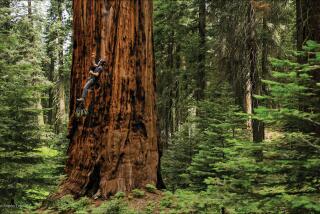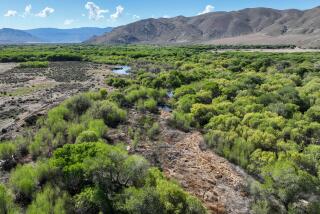Nature Conservancy Changes Its Strategy : Ecology: The organization is trying to preserve entire ecosystems, rather than pieces of land that might be home to a single rare plant or animal.
LYME, Conn. — From a rock outcrop in the woods off Route 156, the expansive view is one of brooks and streams, marshes and forests, all of it dominated by the massive, moving presence of the Connecticut River.
What Leslie N. Corey Jr. of the Nature Conservancy sees from this outlook is more than the alluring landscape of lower Connecticut. He sees the conclusion of the biggest ecological system in New England, a scenic chunk of a 410-mile river that remarkably has escaped the worst excesses of the Industrial Revolution.
So far, anyway.
This river that begins as a rivulet at the Canadian border and ends in a vast, sprawling slab of water at Long Island Sound is the object of a new effort that constitutes the vanguard of conservation in America today.
The Nature Conservancy, one of the nation’s richest, quietest environmental groups--and owner of the largest private sanctuary system in the world--is using the Connecticut River as an example of a new approach to preserving natural areas. It is a difficult, time-consuming and costly attempt to preserve entire ecosystems, rather than pieces of land that might be home to a single rare plant or animal.
Even for an organization with more than 500,000 members, a bank account approaching $100 million and a nationwide staff of more than 1,000, it is an approach that will require not only more money, but innovation, compromise and cooperation.
“Saving scattered sites is not enough,” said Corey, a vice president of the conservancy and executive director of its Connecticut chapter. “We have to find ways to link these sites together.”
One reason is that conservationists increasingly believe that small nature preserves are too vulnerable to damage from adjoining development, from a localized natural disaster or the more insidious threats of global warming and acid rain.
What is needed, ecologists believe, are large natural areas tied together well enough that plants are buffered, animals have elbow room and the natural system can continue to interact.
An example of what can happen to a small preserve occurred in July in Cornwall, Conn. Cathedral Pines, one of the last stands of ancient pine forest in New England, was flattened by a tornado. Had the preserve been larger than its 43 acres, some of its 200- and 300-year-old white pines might have survived.
The conservancy also is applying the new ecosystem approach to preservation efforts on the Delaware River in Delaware, New York, New Jersey and Pennsylvania; a new tall-grass prairie preserve in Oklahoma; Big Darby Creek in Ohio, and the Carrizo Plains in California.
Through the years, the conservancy has gained a reputation for moving swiftly to protect valuable, threatened land, often rescuing state governments unable to rush a land purchase through the bureaucracy.
“They’re an outstanding partner,” said Vermont Gov. Madeleine M. Kunin, who worked with the conservancy last year to save several large parcels of threatened pristine lands. “We’ve worked with the Nature Conservancy in Vermont very successfully,” she said.
In the case of the Connecticut River project, the conservancy began by identifying 100 properties of urgent ecological importance. These were a wide variety of natural areas such as bogs, grasslands, old forests or rocky cliffs where unusual plants and animals could be found.
Now the group, working in the four New England states drained by the river--Connecticut, Massachusetts, New Hampshire and Vermont--is looking for ways to thread together all those areas and other undisturbed landscapes.
“It’s not going to be a continuous preserve; it’s impossible to do that now,” Corey said. “What we have to do is work with what has been left undeveloped and identify what are the most critical elements of the system.”
The lower Connecticut River escaped major industrial development in part because its mouth is comparatively shallow and not desirable for heavy shipping. The area is rich in plant and animal life. As Corey spoke, a northern harrier flew across Lords Cove below, possibly the only place in the state where that hawk breeds.
“There’s a lot of development pressure here,” he said. “Land values have been escalating very rapidly. There’s so much pressure because people want to be next to the river. We didn’t have the vision to see, as the river got cleaner, everyone was going to get back on the river and use it.”
Looking at larger natural systems is forcing the conservancy to seek new tools and new approaches. Until now, if the conservancy deemed some land worthy, the checkbook was ready. In Connecticut, the conservancy has bought or has legal interest in more than 18,000 acres of land in scores of parcels.
Although the conservancy’s bank account has soared along with its membership in recent years--nationally it maintains a $98 million revolving capital account--it realizes it never could afford to purchase whole ecosystems, or even come close.
“We’re not going to buy the entire Connecticut River,” said Dennis B. Wolkoff, the conservancy’s eastern regional director, based in Boston. “So it is beginning to raise the question whether there are other protection tools we will have to use.”
In one creative approach in New York’s Adirondack Mountains, which could serve as a model, the conservancy is completing a deal in which it bought the development rights to one 10,000-acre piece of timberland. But instead of paying the company in cash, the conservancy gave the timber company cutting rights on another 10,000 acres it owns.
The conservancy will end up with 20,000 acres preserved for no use other than logging--at far less cost than buying it outright. The timber company will get twice as much land to log--and reduce the value of its assets on paper, a not insignificant hedge against hostile takeovers.
While the conservancy might once have opposed logging on its lands, it now believes that a healthy timber-based economy is important and that logging often is preferable to shopping centers or condominiums. “If that economy in northern New England can’t be sustained,” Wolkoff said, “then the whole thing will be cut up.”
One reason the conservancy has been able to work such deals with industry is its approach. Among the major environmental groups, the conservancy probably is the least confrontational. Demonstrations or blistering condemnations of polluters and industry are not its style.
“We’ve always had a little bit of a lower profile,” Corey said. “We tend to want to foster partnerships, whether it be with government or with other nonprofits, or local agencies or whatever.”
Growth of the organization has been striking. Incorporated in 1951 with a handful of members, the conservancy now has a membership of 540,000--15,000 in Connecticut. The Connecticut chapter has a yearly operating budget of about $600,000 and spends another $1 million buying and maintaining land. Counting the property it buys on behalf of public agencies, each year the chapter is involved in deals worth several million dollars.
Nationally, it has through various means--purchase, easements or a handshake--set aside more than 4 million acres, an area larger than Connecticut.
For the most part, largely because of its style, the conservancy has managed to avoid major controversy. But not everything it does meets with universal approval. Some advocacy environmental groups say that the conservancy is too quiet.
And not everyone agrees land should be left wild. In Teton County, Mont., for example, ranchers complained the conservancy was creating “a grizzly bear farm” by assembling a wilderness preserve. They said the grizzlies, a threatened species, kill livestock.
Still, the conservancy gets far more praise than condemnation.
Its style is unabashedly businesslike; its membership and board of directors are typically well-to-do and educated, a blend of business people and scientists. In fact, the entire organization is a blend of science and business.
“We do strategic planning,” Corey said. “All of our people are evaluated each year on their performance. We are very performance-oriented, very pragmatic in the way we go about doing our business.
“Our formula for going about doing what we do has been non-confrontational. It’s been a process that respects the private property rights of individuals, of corporations, whomever. Our whole basis of land ownership is based on preserving individual rights, and the conservancy works within that and respects that, and that is why we aren’t flamboyant.”
Quietly, the conservancy has created within all 50 states a computer database with information on all locations of rare plants and animals. Those data are drawn from scientists throughout the country.
Though it is little known, the conservancy has given those databases to state governments to use in planning.
The way the conservancy sees it, if a developer knows right away a rare plant grows on a property, the developer will want to take it into account in order to avoid conflict later.
That database also helps the conservancy design major preserves, even on the scale of the Connecticut River project, which likely will proceed for many years.
If it can, the conservancy starts by encouraging the owners of ecologically valuable property to donate it to the conservancy. In other cases it will purchase conservation easements, whereby a property owner agrees not to develop an area. If it needs to, and a property owner is willing, the conservancy buys the land outright.
In recent years it has worked increasingly with the well-to-do, demonstrating the tax advantages of gifts of stock or land--tax breaks that often allow the conservancy to buy land far below its market value.
“Uncle Sam is the silent partner in every land transaction we do, because the tax laws in this country are set up to give recognition to people who are making gifts or some portion of a gift that provides public benefit,” Corey said.
More to Read
Sign up for Essential California
The most important California stories and recommendations in your inbox every morning.
You may occasionally receive promotional content from the Los Angeles Times.










